The terrifying new weapon altering the conflict in Ukraine
BBC Information
An acrid scent hangs over the city of Rodynske. A few minutes after we drive into town we see the place it is coming from.
A 250kg glide bomb has ripped by the city’s foremost administrative constructing, and brought down three residential blocks. We’re visiting a day after the bomb struck, however elements of the wreckage are nonetheless smoking. From the perimeters of the city we hear the sound of artillery fireplace, and of gunshots – Ukrainian troopers capturing down drones.
Rodynske is about 15km (9 miles) north of the embattled metropolis of Pokrovsk. Russia has been making an attempt to seize it from the south because the autumn of final 12 months, however Ukrainian forces have to date managed to cease Russian troopers from marching in.
So Russia has modified ways, transferring as a substitute to encircle town, slicing off provide routes.
Prior to now two weeks, as hectic diplomatic efforts to deliver a couple of ceasefire in Ukraine have failed, Russia has intensified its push, making its most vital advances since January.
We discover proof of that in Rodynske.
Inside minutes of us arriving on the town, we hear a Russian drone above us. Our crew runs to the closest cowl accessible – a tree.
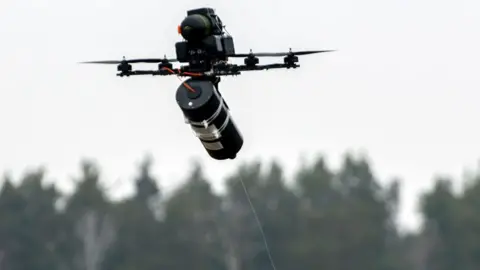 Getty Pictures
Getty PicturesWe press up towards it so the drone will not see us. Then there’s the sound of a loud explosion – it is a second drone making influence close by. The drone above us continues to be hovering. For a couple of extra minutes, we hear the terrifying whirring sound of what is grow to be the deadliest weapon of this conflict.
After we cannot hear it any extra we take the possibility to run to onerous cowl in an deserted constructing 100ft away.
From the shelter, we hear the drone once more. It is potential it returned after seeing our motion.
That Rodynske is being swarmed by Russian drones is proof that the assaults are coming from positions a lot nearer than identified Russian positions to the south of Pokrovsk. They had been more than likely coming from newly captured territory on a key highway working from the east of Pokrovsk to Kostyantynivka.
After half an hour of ready within the shelter, after we cannot hear the drone anymore, we transfer rapidly to our automotive parked below tree cowl, and velocity out of Rodynske. By the facet of the freeway we see smoke billowing and one thing burning – it is more than likely a downed drone.
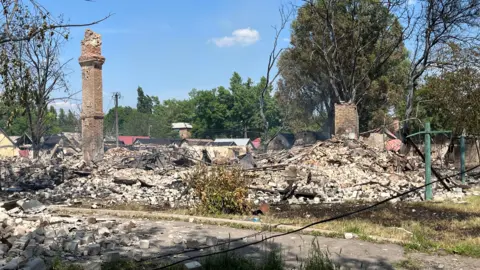
We drive to Bilytske, additional away from the frontline. We see a row of homes destroyed by a missile strike in a single day. One in every of them was Svitlana’s dwelling.
“It is getting worse and worse. Earlier, we might hear distant explosions, they had been distant. However now our city is getting focused – we’re experiencing it ourselves,” says the 61-year-old, as she picks up a couple of belongings from the wreckage of her dwelling. Fortunately Svitlana wasn’t at dwelling when the assault occurred.
“Go into the centre of the city, you may see a lot that’s destroyed there. And the bakery and zoo have been destroyed too,” she says.
At a safehouse simply out of attain of drones, we meet troopers of the artillery unit of the fifth Assault Brigade.
“You may really feel the depth of Russian assaults growing. Rockets, mortars, drones, they’re utilizing every thing they’ve to chop off provide routes going into town,” says Serhii.
His unit has been ready for 3 days to deploy to their positions, ready for cloud cowl or high-speed winds to present them safety from drones.
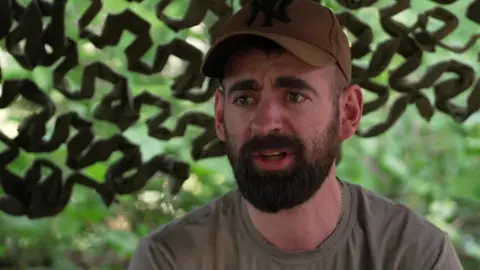
In an ever-evolving battle, troopers have needed to quickly adapt to new threats posed by altering know-how. And the most recent risk comes from fibre optic drones. A spool of tens of kilometres of cable is fitted to the underside of a drone and the bodily fibre optic twine is connected to the controller held by the pilot.
“The video and management sign is transmitted to and from the drone by the cable, not by radio frequencies. This implies it might’t be jammed by digital interceptors,” says a soldier with the decision signal Moderator, a drone engineer with the 68th Jaeger Brigade.
When drones started for use on this conflict in a giant means, each militaries fitted their autos with digital warfare techniques, which might neutralise drones. That safety has evaporated with the arrival of fibre optic drones, and within the deployment of those units, Russia at the moment has the sting. Ukraine is making an attempt to ramp up manufacturing.
“Russia began utilizing fibre optic drones a lot earlier than us, whereas we had been nonetheless testing them. These drones can be utilized in locations the place we’ve got to go decrease than normal drones. We will even enter homes and search for targets inside,” says Venia, a drone pilot with the 68th Jaeger Brigade.
“We have began joking that perhaps we should always carry scissors to chop the twine,” says Serhii, the artillery man.
Fibre optic drones do have drawbacks – they’re slower and the cable might get entangled in bushes. However in the meanwhile, their widespread use by Russia signifies that transporting troopers to and from their positions can typically be deadlier than the battlefield itself.
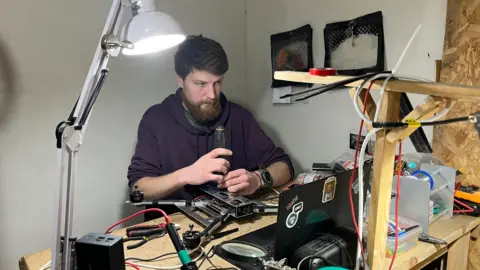
“Whenever you enter a place, you do not know whether or not you have been noticed or not. And when you’ve got been noticed, then it’s possible you’ll already be dwelling the final hours of your life,” says Oles, Chief Sergeant of the reconnaissance unit of the fifth Assault Brigade.
This risk signifies that troopers are spending longer and longer of their positions.
Oles and his males are within the infantry, serving within the trenches proper on the very entrance of Ukraine’s defence. It is uncommon for journalists nowadays to talk to soldiers, because it’s grow to be too dangerous to go to those trenches. We meet Oles and Maksym in a rural dwelling transformed right into a makeshift base, the place the troopers come to relaxation after they’re not on deployment.
“The longest I spent on the place was 31 days, however I do know guys who’ve spent 90 and even 120 days there. Again earlier than the drones arrived, the rotations might have been between 3 or 7 days on the place,” says Maksym.
“Conflict is blood, dying, moist mud and a chill that spreads from head to toe. And that is the way you spend day-after-day. I bear in mind one occasion after we did not sleep for 3 days, alert each minute. The Russians saved coming at us wave after wave. Even a minor lapse would have meant we had been lifeless.”
Oles says Russia’s infantry has modified its ways. “Earlier they attacked in teams. Now they solely ship one or two individuals at occasions. In addition they use bikes and in a couple of situations, quad bikes. Typically they slip by.”
What this implies is that the entrance strains in some elements are not standard strains with the Ukrainians on one facet and the Russians on the opposite, however extra like items on a chessboard throughout play, the place positions may be intertwined.
This additionally makes it tougher to see advances made by both facet.
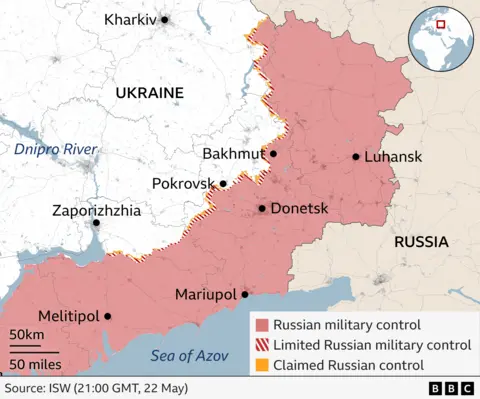
Regardless of Russia’s latest positive aspects, it won’t be fast or simple for it to take the entire of the Donetsk area, the place Pokrovsk lies.
Ukraine has pushed again onerous, but it surely wants a gradual provide of weapons and ammunition to maintain the battle.
And because the conflict enters a fourth summer season, Ukraine’s manpower points towards a a lot larger Russian military are additionally evident. A lot of the troopers we meet joined the navy after the conflict started. They’ve had a couple of months of coaching, however have needed to be taught rather a lot on the job in the midst of a raging conflict.
Maksym labored for a drinks firm earlier than he joined the navy. I requested how his household copes together with his job.
“It is onerous, it is actually onerous. My household actually helps me. However I’ve a two-year-old son, and I do not get to see him a lot. I do video name him although, so every thing is as advantageous because it might be below the circumstances,” he trails off, eyes welling up with tears.
Maksym is a soldier preventing for his nation, however he is additionally only a father lacking his two-year-old boy.
Further reporting by Imogen Anderson, Sanjay Ganguly, Volodymyr Lozhko and Anastasiia Levchenko


